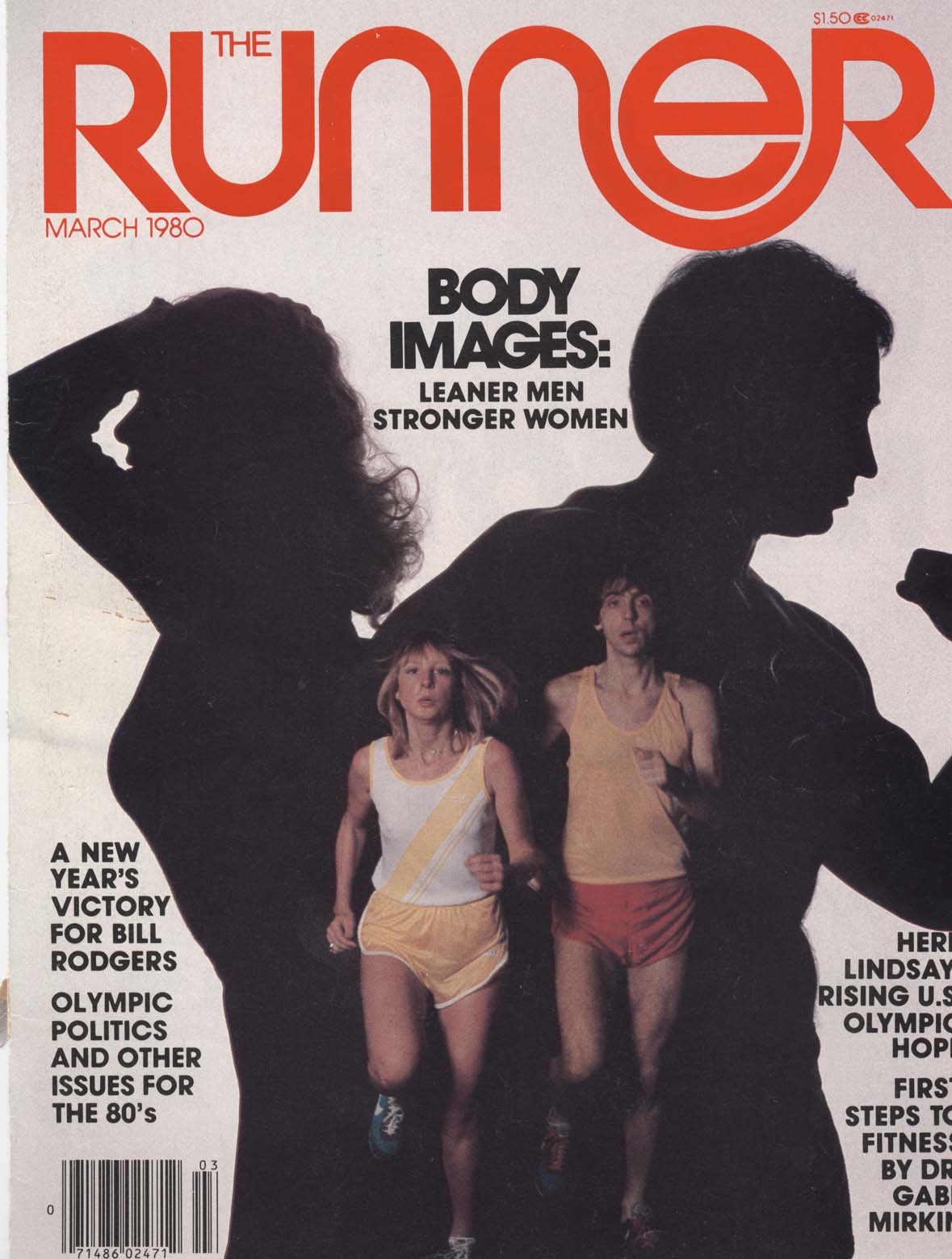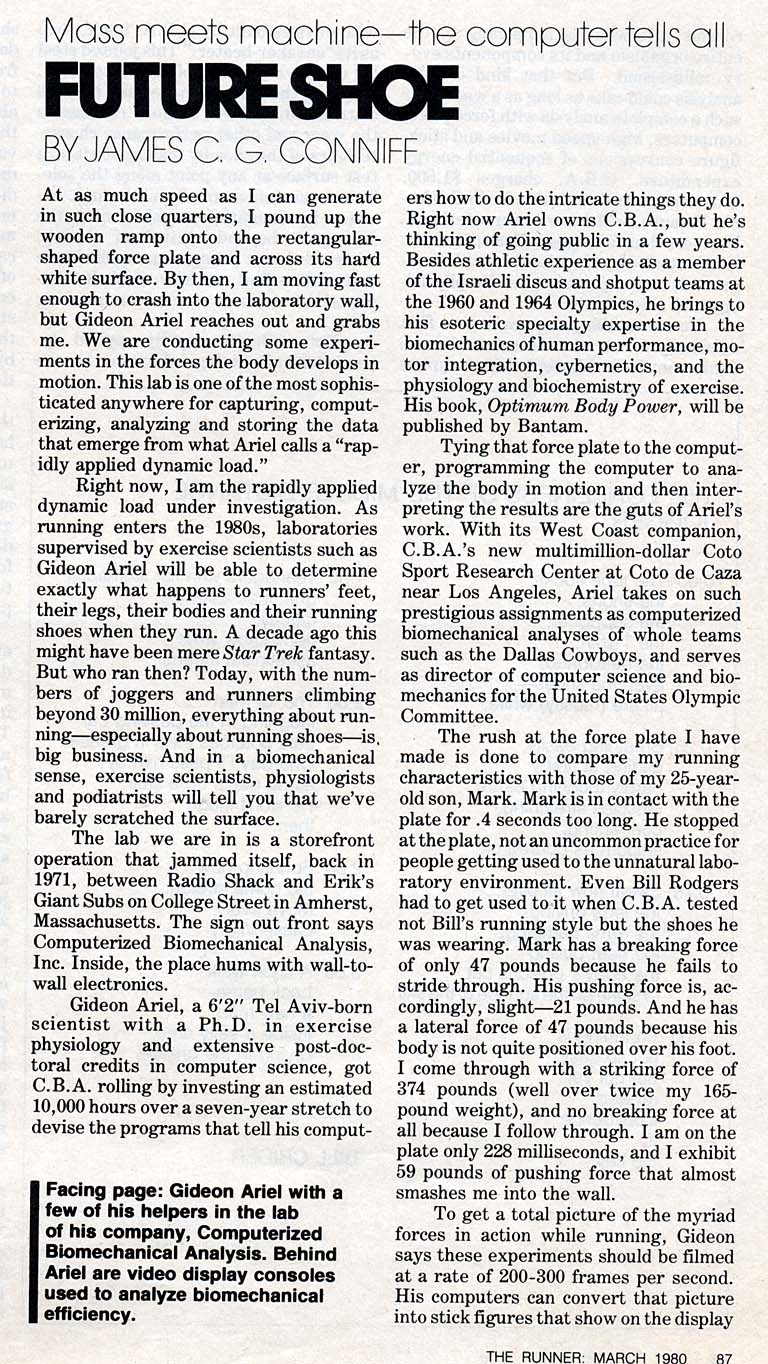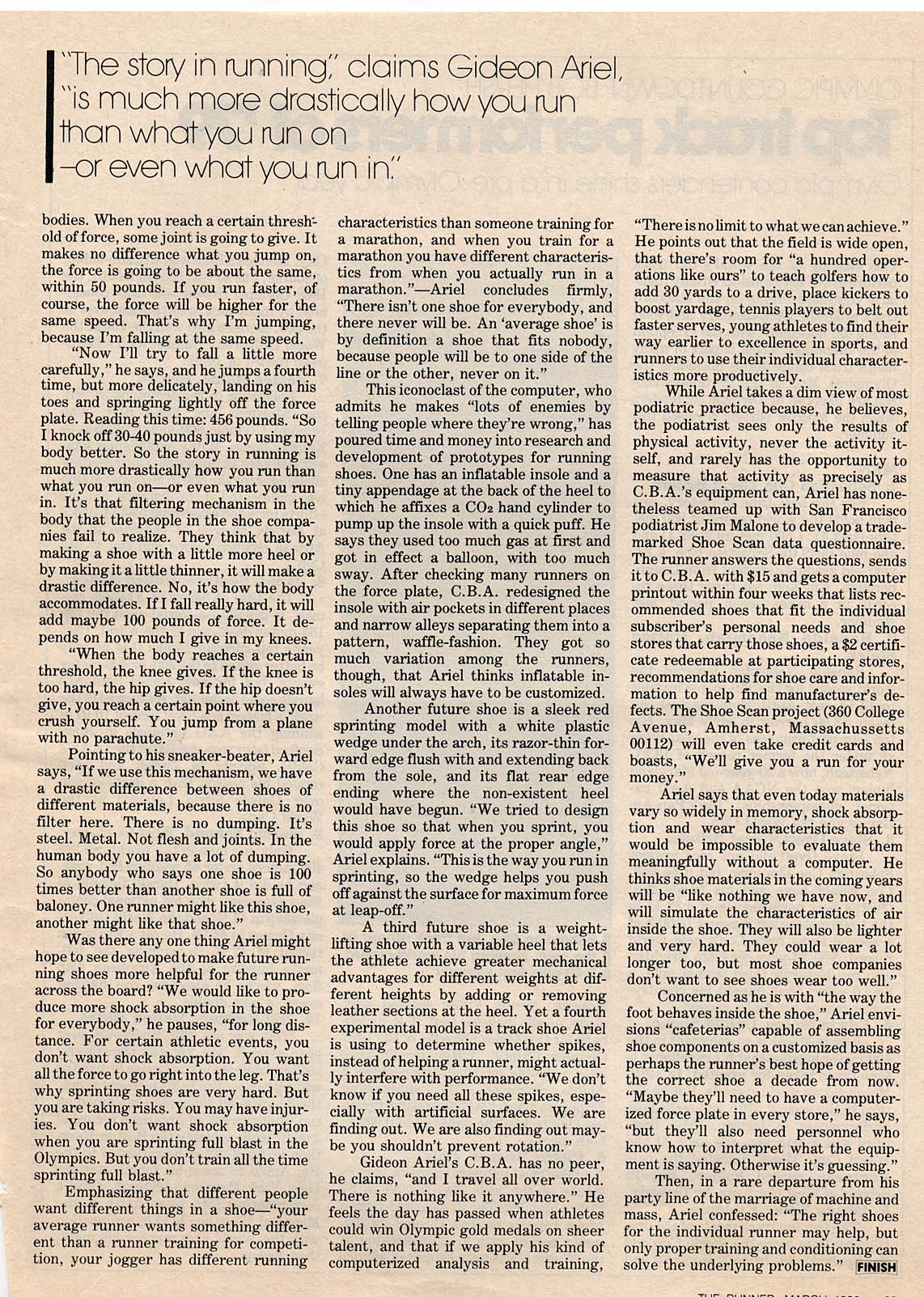Future Shoe
Mass meets machine - the computer tells all
By James Conniff in The Runner on Saturday, March 1, 1980
In the article "Mass meets machine-the computer tells all" by Javes C. G. Cu\iff, the author explores the use of computer technology in analyzing the biomechanics of running. The article focuses on the work of Gideon Ariel, a scientist with a Ph.D. in exercise physiology and extensive postdoctoral credits in computer science, who has developed programs to analyze the forces the body develops in motion. Ariel's lab, Computerized Biomechanical Analysis, Inc., uses a force plate to capture, computerize, analyze, and store data from runners. The author discusses the potential of this technology to improve running shoes and training methods, and Ariel's belief that there is no "one shoe for everybody". Ariel also discusses the future of running shoes, envisioning materials that simulate the characteristics of air inside the shoe and the potential for customized shoe assembly.
Tip: use the left and right arrow keys
Mass meets machine-the computer tells all
FUTURE SF10E
BYJAVES C. G. CU\IFF
At as much speed as I can generate in such close quarters, I pound up the wooden ramp onto the rectangularshaped force plate and across its hard white surface. By then, I am moving fast enough to crash into the laboratory wall, but Gideon Ariel reaches out and grabs me. We are conducting some experiments in the forces the body develops in motion. This lab is one of the most sophisticated anywhere for capturing, computerizing, analyzing and storing the data that emerge from what Ariel calls a "rapidly applied dynamic load."
Right now, I am the rapidly applied dynamic load under investigation. As running enters the 1980s, laboratories supervised by exercise scientists such as Gideon Ariel will be able to determine exactly what happens to runners' feet, their legs, their bodies and their running shoes when they run. A decade ago this might have been mere Star Trek fantasy. But who ran then? Today, with the numbers of joggers and runners climbing beyond 30 million, everything about running-especially about running shoes-is. big business. And in a biomechanical sense, exercise scientists, physiologists and podiatrists will tell you that we've barely scratched the surface.
The lab we are in is a storefront operation that jammed itself, back in 1971, between Radio Shack and Erik's Giant Subs on College Street in Amherst, Massachusetts. The sign out front says Computerized Biomechanical Analysis, Inc. Inside, the place hums with wall-towall electronics.
Gideon Ariel, a 6'2" Tel Aviv-born scientist with a Ph.D. in exercise physiology and extensive postdoctoral credits in computer science, got C.B.A. rolling by investing an estimated 10,000 hours over a seven-year stretch to devise the programs that tell his comput
Facing page: Gideon Ariel with a few of his helpers in the lab of his company, Computerized Biomechanical Analysis. Behind Ariel are video display consoles used to analyze biomechanical efficiency.
ers how to do the intricate things they do. Right now Ariel owns C.B.A., but he's thinking of going public in a few years. Besides athletic experience as a member of the Israeli discus and shotput teams at the 1960 and 1964 Olympics, he brings to his esoteric specialty expertise in the biomechanics of human performance, motor integration, cybernetics, and the physiology and biochemistry of exercise. His book, Optimum Body Power, will be published by Bantam.
Tying that force plate to the computer, programming the computer to analyze the body in motion and then interpreting the results are the guts of Ariel's work. With its West Coast companion, C.B.A.'s new multimillion-dollar Coto Sport Research Center at Coto de Caza near Los Angeles, Ariel takes on such prestigious assignments as computerized biomechanical analyses of whole teams such as the Dallas Cowboys, and serves as director of computer science and biomechanics for the United States Olympic Committee.
The rush at the force plate I have made is done to compare my running characteristics with those of my 25-yearold son, Mark. Mark is in contact with the plate for .4 seconds too long. He stopped at the plate, not an uncommon practice for people getting used to the unnatural laboratory environment. Even Bill Rodgers had to get used to it when C.B.A. tested not Bill's running style but the shoes he was wearing. Mark has a breaking force of only 47 pounds because he fails to stride through. His pushing force is, accordingly, slight-21 pounds. And he has a lateral force of 47 pounds because his body is not quite positioned over his foot. I come through with a striking force of 374 pounds (well over twice my 165pound weight), and no breaking force at all because I follow through. I am on the plate only 228 milliseconds, and I exhibit 59 pounds of pushing force that almost smashes me into the wall.
To get a total picture of the myriad forces in action while running, Gideon says these experiments should be filmed at a rate of 200-300 frames per second. His computers can convert that picture into stick figures that show on the display
THE RUNNER. MARCH 1980 87
console just what is happening to the entire organism and its components every millisecond. But that kind of total analysis could take as long as a week. For such a complete analysis with force plate, computers, high-speed movies and stickfigure conversions of sequential energy expenditure, C.B.A. charges $1,500. Gideon expects to trim this fee in California because he'll have lower overhead. Business thus far is good. Each of the two labs is staffed by six scientists with backgrounds in computers, exercise physiology and allied fields.
To create this program, it was first necessary for Ariel to interface diverse equipment from different manufacturers with devices built by C.B.A. itself, such as its "sneaker-beater." This jointed steel leg can have any kind of shoe fitted to it. Knowing the mass of the leg and how it's distributed, C.B.A. staffers can assess the wear and other performance characteristics of the shoe by making it hit on a test surface at any point along the sole. This is an important breakthrough because, by simulating actual running, the sole goes beyond static-load testing, where constant pressure is applied to a material to find out how much it compresses or when it reaches its breaking point.
But while the rapidly applied dynamic load of running deforms or breaks
1.50 Teenagers with flat stomachs grin, look askance, catcall,
don't know what asceticism means.
2.00 The tat man
laughing in the passing car eats potatoes fried in grease. One day I'll pass him by as he pants up a stair. He won't laugh then.
2.50 Sprinting now, the home stretch. Move over Lasse Viren.
3.00 A short walk
back homea new man
inside a salty rime, drying in the breeze.
BILL CRIDER
shoe materials sooner than a static load does, that dynamic load varies too much from runner to runner, and even from run to run in the same runner, to be dependable. The sneaker-beater takes care of that problem by smoothing out these variables to make the results more predictably uniform. Its ram is attached to a displacement transducer so that it can measure both force and displacement simultaneously. That gives C.B.A. accurate measurements of the actual behavior of the material, shows how it absorbs energy and how it recovers, spells out its stiffness and energy-loss and so on. All this information is reduced to usable form by the computer for instant visual evaluation on its display console.
The force plate can measure force in three coordinate dimensions-vertical, horizontal and longitudinal. It also measures twist or rotation. The plate is designed around special piezo-electric crystals that are built up in layers with the grain going in different directions. The direction of the grain determines which force it will measure. With the sensitivity turned up, the force plate can detect the presence of a fly.
Asked about the improvements he expects in running shoes over the next decade, Ariel climbs up on an ordinary metal folding chair and jumps three times in a row from the chair to the force plate. The first jump is onto the bare surface, and the computer shows he hit with a force of 493 pounds, more than double his body weight of 218. Next he jumps onto an athletic-mat material made by Dow called Epifoam, a tough and resilient synthetic about an inch thick, and generates a force of 488 pounds. When he jumps the third time onto yet another artificial foam of the same thickness but supposedly even more shock-absorbing than Epifoam, the computer display panel reads 504 pounds-more force than was transmitted to Ariel's body when he jumped onto the naked hardness of the force plate. For further demonstration, he drops a calculus textbook three times onto the same sequence of surfaces, and from the same height, and gets force readings of 63, 136 and 116 pounds, respectively.
"What does that tell us?" asks Ariel rhetorically in his Israeli accent. "With the book we saw a drastic difference. With the human body, we don't see a drastic difference. The reason the force will be approximately the same no matter how often I jump, or what I jump on, is that we have a filtering system inside our
THE LONELINESS OF THE MIDDLE-DISTANCE JOGGER
0.00 The tube socks,
the shorts, the supporter, the T-shirt,
the headband, even the shoes
all are (mostly) white.
0.25 Breathing easily, gliding at first,
hardly touching earth. Muscles stretching, contracting, smooth as poured oil.
0.75 Sweat now all over, the legs driving,
the arms pumping, the heat pulling
the body's poisons out
to shine on the surface of the skin.
1.00 Breathing is not so easy, but not yet ragged. Confidence is
the key.
88 THE RUNNER MARCH 1980
"The story in running;' claims Gideon Ariel,
"is much more drastically how you run
nan what you run on
-or even what you run in:"
bodies. When you reach a certain thresh= old of force, some joint is going to give. It makes no difference what you jump on, the force is going to be about the same, within 50 pounds. If you run faster, of course, the force will be higher for the same speed. That's why I'm jumping, because I'm falling at the same speed.
"Now I'll try to fall a little more carefully," he says, and he jumps a fourth time, but more delicately, landing on his toes and springing lightly off the force plate. Reading this time: 456 pounds. "So I knock off 30-40 pounds just by using my body better. So the story in running is much more drastically how you run than what you run on-or even what you run in. It's that filtering mechanism in the body that the people in the shoe companies fail to realize. They think that by making a shoe with a little more heel or by making it a little thinner, it will make a drastic difference. No, it's how the body accommodates. If I fall really hard, it will add maybe 100 pounds of force. It depends on how much I give in my knees.
"When the body reaches a certain threshold, the knee gives. If the knee is too hard, the hip gives. If the hip doesn't give, you reach a certain point where you crush yourself. You jump from a plane with no parachute."
Pointing to his sneaker-beater, Ariel says, "If we use this mechanism, we have a drastic difference between shoes of different materials, because there is no filter here. There is no dumping. It's steel. Metal. Not flesh and joints. In the human body you have a lot of dumping. So anybody who says one shoe is 100 times better than another shoe is full of baloney. One runner might like this shoe, another might like that shoe."
Was there any one thing Ariel might hope to see developed to make future running shoes more helpful for the runner across the board? "We would like to produce more shock absorption in the shoe for everybody," he pauses, "for long distance. For certain athletic events, you don't want shock absorption. You want all the force to go right into the leg. That's why sprinting shoes are very hard. But you are taking risks. You may have injuries. You don't want shock absorption when you are sprinting full blast in the Olympics. But you don't train all the time sprinting full blast."
Emphasizing that different people want different things in a shoe-"your average runner wants something different than a runner training for competition, your jogger has different running characteristics than someone training for a marathon, and when you train for a marathon you have different characteristics from when you actually run in a marathon. "-Ariel concludes firmly, "There isn't one shoe for everybody, and there never will be. An `average shoe' is by definition a shoe that fits nobody, because people will be to one side of the line or the other, never on it."
This iconoclast of the computer, who admits he makes "lots of enemies by telling people where they're wrong," has poured time and money into research and development of prototypes for running shoes. One has an inflatable insole and a tiny appendage at the back of the heel to which he affixes a CO2 hand cylinder to pump up the insole with a quick puff. He says they used too much gas at first and got in effect a balloon, with too much sway. After checking many runners on the force plate, C.B.A. redesigned the insole with air pockets in different places and narrow alleys separating them into a pattern, waffle-fashion. They got so much variation among the runners, though, that Ariel thinks inflatable insoles will always have to be customized.
Another future shoe is a sleek red sprinting model with a white plastic wedge under the arch, its razor-thin forward edge flush with and extending back from the sole, and its flat rear edge ending where the non-existent heel would have begun. "We tried to design this shoe so that when you sprint, you would apply force at the proper angle," Ariel explains. "This is the way you run in sprinting, so the wedge helps you push off against the surface for maximum force at leap-off."
A third future shoe is a weightlifting shoe with a variable heel that lets the athlete achieve greater mechanical advantages for different weights at different heights by adding or removing leather sections at the heel. Yet a fourth experimental model is a track shoe Ariel is using to determine whether spikes, instead of helping a runner, might actually interfere with performance. "We don't know if you need all these spikes, especially with artificial surfaces. We are finding out. We are also finding out maybe you shouldn't prevent rotation."
Gideon Ariel's C.B.A. has no peer, he claims, "and I travel all over world. There is nothing like it anywhere." He feels the day has passed when athletes could win Olympic gold medals on sheer talent, and that if we apply his kind of computerized analysis and training,
"There is no limit to what we can achieve." He points out that the field is wide open, that there's room for "a hundred operations like ours" to teach golfers how to add 30 yards to a drive, place kickers to boost yardage, tennis players to belt out faster serves, young athletes to find their way earlier to excellence in sports, and runners to use their individual characteristics more productively.
While Ariel takes a dim view of most podiatric practice because, he believes, the podiatrist sees only the results of physical activity, never the activity itself, and rarely has the opportunity to measure that activity as precisely as C.B.A.'s equipment can, Ariel has nonetheless teamed up with San Francisco podiatrist Jim Malone to develop a trademarked Shoe Scan data questionnaire. The runner answers the questions, sends it to C. B. A. with $15 and gets a computer printout within four weeks that lists recommended shoes that fit the individual subscriber's personal needs and shoe stores that carry those shoes, a $2 certificate redeemable at participating stores, recommendations for shoe care and information to help find manufacturer's defects. The Shoe Scan project (360 College Avenue, Amherst, Massachussetts 00112) will even take credit cards and boasts, "We'll give you a run for your money."
Ariel says that even today materials vary so widely in memory, shock absorption and wear characteristics that it would be impossible to evaluate them meaningfully without a computer. He thinks shoe materials in the coming years will be "like nothing we have now, and will simulate the characteristics of air inside the shoe. They will also be lighter and very hard. They could wear a lot longer too, but most shoe companies don't want to see shoes wear too well."
Concerned as he is with "the way the foot behaves inside the shoe," Ariel envisions "cafeterias" capable of assembling shoe components on a customized basis as perhaps the runner's best hope of getting the correct shoe a decade from now. "Maybe they'll need to have a computerized force plate in every store," he says, "but they'll also need personnel who know how to interpret what the equipmerit is saying. Otherwise it's guessing."
Then, in a rare departure from his party line of the marriage of machine and mass, Ariel confessed: "The right shoes for the individual runner may help, but only proper training and conditioning can solve the underlying problems." FINISH





